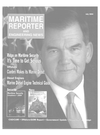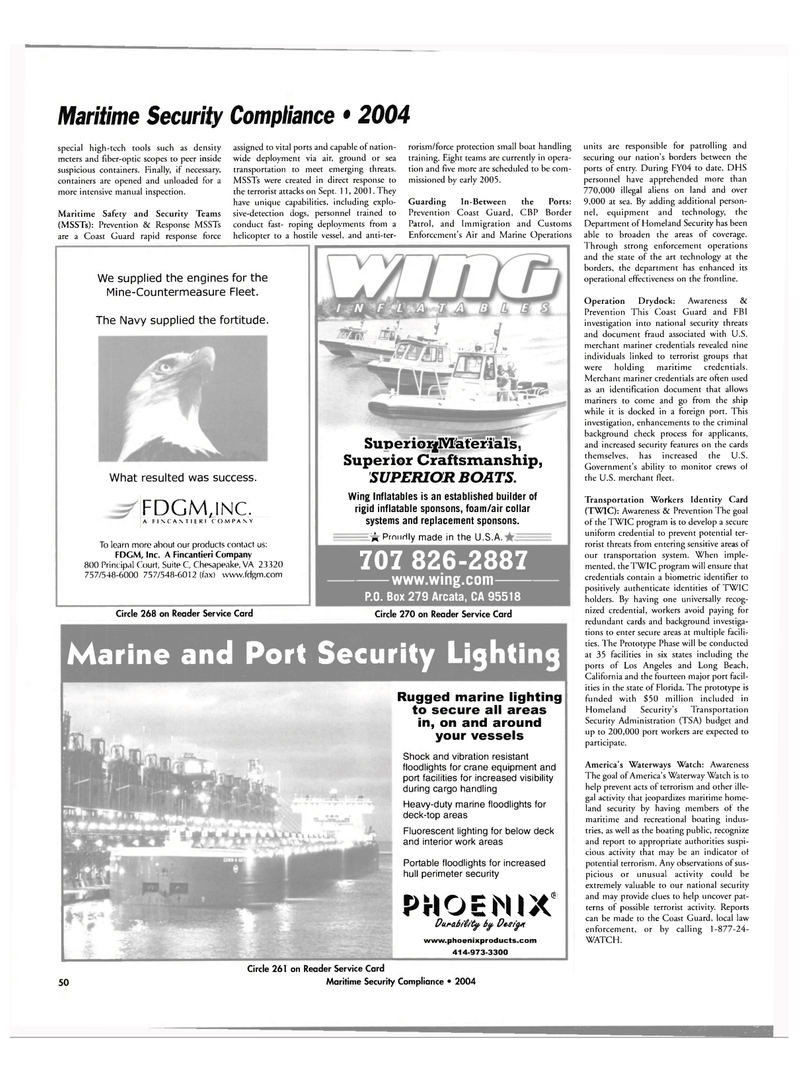
Page 50: of Maritime Reporter Magazine (July 2004)
Gulf of Mexico: Floating Production Systems & Support Vessels
Read this page in Pdf, Flash or Html5 edition of July 2004 Maritime Reporter Magazine
Maritime Security Compliance • 2004 special high-tech tools such as density meters and fiber-optic scopes to peer inside suspicious containers. Finally, if necessary, containers are opened and unloaded for a more intensive manual inspection.
Maritime Safety and Security Teams (MSSTs): Prevention & Response MSSTs are a Coast Guard rapid response force assigned to vital ports and capable of nation- wide deployment via air, ground or sea transportation to meet emerging threats.
MSSTs were created in direct response to the terrorist attacks on Sept. 1 1, 2001. They have unique capabilities, including explo- sive-detection dogs, personnel trained to conduct fast- roping deployments from a helicopter to a hostile vessel, and anti-ter- rorism/force protection small boat handling training. Eight teams are currently in opera- tion and five more are scheduled to be com- missioned by early 2005.
Guarding In-Between the Ports:
Prevention Coast Guard, CBP Border
Patrol, and Immigration and Customs
Enforcement's Air and Marine Operations units are responsible for patrolling and securing our nation's borders between the ports of entry. During FY04 to date, DHS personnel have apprehended more than 770,000 illegal aliens on land and over 9,000 at sea. By adding additional person- nel, equipment and technology, the
Department of Homeland Security has been able to broaden the areas of coverage.
Through strong enforcement operations and the state of the art technology at the borders, the department has enhanced its operational effectiveness on the frontline.
Operation Drydock: Awareness &
Prevention This Coast Guard and FBI investigation into national security threats and document fraud associated with U.S. merchant mariner credentials revealed nine individuals linked to terrorist groups that were holding maritime credentials.
Merchant mariner credentials are often used as an identification document that allows mariners to come and go from the ship while it is docked in a foreign port. This investigation, enhancements to the criminal background check process for applicants, and increased security features on the cards themselves, has increased the U.S.
Government's ability to monitor crews ol the U.S. merchant fleet.
Transportation Workers Identity Card (TW1C): Awareness & Prevention The goal of the TWIC program is to develop a secure uniform credential to prevent potential ter- rorist threats from entering sensitive areas of our transportation system. When imple- mented, the TWIC program will ensure that credentials contain a biometric identifier to positively authenticate identities of TWIC holders. By having one universally recog- nized credential, workers avoid paying for redundant cards and background investiga- tions to enter secure areas at multiple facili- ties. The Prototype Phase will be conducted at 35 facilities in six states including the ports of Los Angeles and Long Beach,
California and the fourteen major port facil- ities in the state of Florida. The prototype is funded with $50 million included in
Homeland Security's Transportation
Security Administration (TSA) budget and up to 200,000 port workers are expected to participate.
America's Waterways Watch: Awareness
The goal of America's Waterway Watch is to help prevent acts of terrorism and other ille- gal activity that jeopardizes maritime home- land security by having members of the maritime and recreational boating indus- tries, as well as the boating public, recognize and report to appropriate authorities suspi- cious activity that may be an indicator of potential terrorism. Any observations of sus- picious or unusual activity could be extremely valuable to our national security and may provide clues to help uncover pat- terns of possible terrorist activity. Reports can be made to the Coast Guard, local law enforcement, or by calling 1-877-24-
WATCH.
We supplied the engines for the
Mine-Countermeasure Fleet.
The Navy supplied the fortitude.
What resulted was success.
FDGM, INC,
A FINCANTIERI C O M P A \ Y
To learn more about our products contact us:
FDGM, Inc. A Fincantieri Company 800 Principal Court, Suite C, Chesapeake, VA 23320 757/548-6000 757/548-6012 (fax) www.fdgm.com
Sup e rio rflVTat e r i al s,
Superior Craftsmanship,
SUPERIOR BOATS.
Wing Inflatables is an established builder of rigid inflatable sponsons, foam/air collar systems and replacement sponsons. •fcProudly made in the U.S.A.
Circle 268 on Reader Service Card 707 826-2887 www.wing.com
P.O. Box 279 Areata, CA 95518
Circle 270 on Reader Service Card
Marine and Port Security Li3htin3
Rugged marine lighting to secure all areas in, on and around your vessels
Shock and vibration resistant floodlights for crane equipment and port facilities for increased visibility during cargo handling
Heavy-duty marine floodlights for deck-top areas
Fluorescent lighting for below deck and interior work areas
Portable floodlights for increased hull perimeter security
PHOENIX1
Durability, by Design www.phoenixproducts.com 414-973-3300 50
Circle 261 on Reader Service Card
Maritime Security Compliance • 2004

 49
49

 51
51
